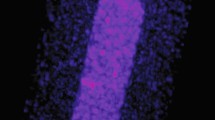Abstract
The use of multinuclear magnetic resonance imaging (MRI) for investigating the distribution of deuterium and perfluorocarbons in laboratory rats is considered. This technique is implementable at any MRI scanner that allows its transmitter and receiver circuitry to be tuned to the necessary Larmor frequencies. It is shown that multinuclear MRI opens up broad prospects for biological and medical in vivo research.
Similar content being viewed by others
References
G.P. Yan, L. Robinson, and P. Hogg, “Magnetic Resonance Imaging Contrast Agents: Overview and Perspectives,” Radiography. 13(1), e5 (2007).
W. Xu, K. Kattel, Y. Chang, T.J. Kim, and G.H. Lee, “Paramagnetic Nanoparticle T1 and T2 MRI Contrast Agents,” Phys. Chem. Chem. Phys. 14(37), 12687 (2012).
J.F. Thomson, “Physiological Effects of D2O in Mammals,” Ann. N.Y. Acad. Sci. 84(16), 736 (1960).
H.G. Barbour and E. Allen, “Tumor Growth in Mice One-Fifth Saturated with Deuterium Oxide,” Am. J. Cancer. 32(3), 440 (1938).
M.W. Biggs, J.E. Eiselein, and G. Wilcox, “Observations on Murine Leukemia Treated with Deuterium and X-Ray,” Cancer Res. 23(7), 1059 (1963).
V.I. Lobyshev and L.P. Kalinichenko, Isotope Effects of D2O in Biological Systems (Nauka, Moscow, 1978) [in Russian].
R.P. Mason, P.P. Antich, E.E. Babcock, J.L. Gerberich, and R.L. Nunnally, “Perfluorocarbon Imaging in vivo: A 19F MRI Study in Tumor-Bearing Mice,” Magn. Reson. Imag. 7(5), 475 (1989).
U. Gross, S. Rüdiger, and H. Reichelt, “Perfluorocarbons: Chemically Inert but Biologically Active?” J. Fluor. Chem. 53(2), 155 (1991).
G.R. Ivanitskii and S.I. Vorob’ev, “The Blood Substitute Perftoran,” Vestnik RAN. 67(11), 998 (1997) [in Russian].
M.V. Gulyaev, L.L. Gervits, Yu.A. Ustynyuk, N.V. Anisimov, Yu.A. Pirogov, and A.R. Khokhlov, “Fluorine-19 Magnetic Resonance Imaging Using Perftoran,” Online Zh. Radioelektroniki. 2013, No. 8 (http://jre.cplire.ru/win/aug13/11/text.html) [in Russian].
Author information
Authors and Affiliations
Corresponding author
About this article
Cite this article
Kosenkov, A.V., Gulyaev, M.V., Anisimov, N.V. et al. Investigation of the distribution of heavy nuclei in laboratory animals using multinuclear magnetic resonance imaging. Phys. Wave Phen. 23, 311–315 (2015). https://doi.org/10.3103/S1541308X15040093
Received:
Published:
Issue Date:
DOI: https://doi.org/10.3103/S1541308X15040093




